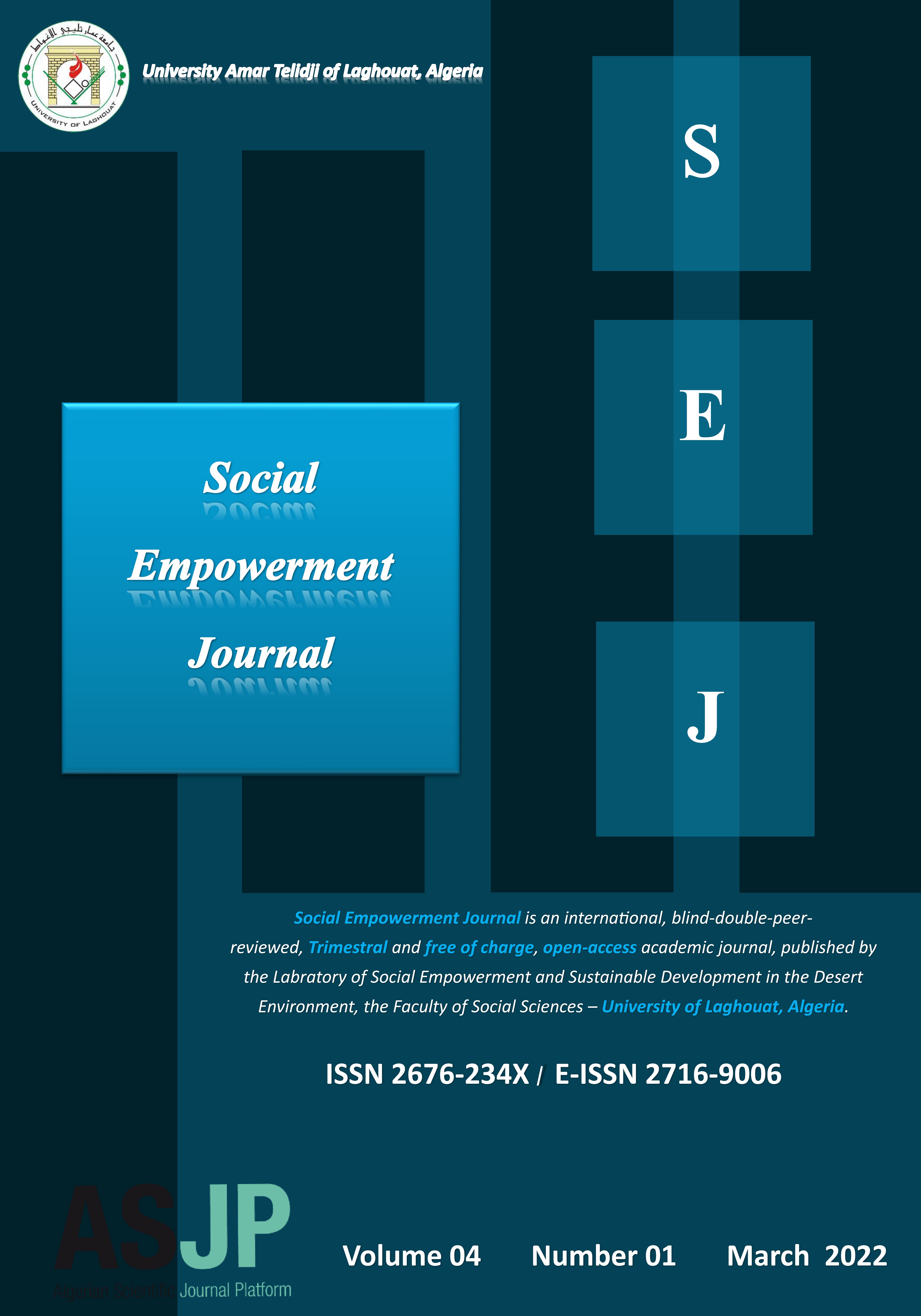السياق الإقتصادي والمالي للرفاهية: شرح متكامل لرأس المال الإجتماعي
الملخص
يعود مفهوم رأس المال الاجتماعي إلى تعريف بورديو، الذي ركز على وجود "شبكة من العلاقات المؤسسية إلى حد ما ... والتي تزود كل فرد من أعضائها بدعم رأس المال الجماعي".
الغرض من هذه الورقة هو التحقق في تأثير رأس المال الاجتماعي على العلاقة بين الرفاهية المالية والاقتصادية والرضا عن الحياة بين الموظفين داخل المؤسسات. الهدف الرئيسي هو تحليل العلاقة بين الأبعاد المختلفة لرأس المال الاجتماعي والرفاهية المالية والاقتصادية الذاتية حيث يناقش هذا المقال الإشكالية التالية: ما هو رأس المال الاجتماعي وكيف يؤثر على الرفاه المالي والاقتصادي؟ تعتمد الدراسة بشكل أساسي على البيانات الثانوية. للأدبيات المتعلقة بالموضوع من قواعد بيانات مختلفة حيث تم جمع مواقع الويب والمصادر الأخرى المتاحة. وللإجابة على أسئلة البحث تم إجراء مراجعة الأدبيات واختيار المقالات من قواعد البيانات العلمية مثل Emerald و Sage Premier و ScienceDirect و Springer Open و Google Scholar. بحثنا في الأدبيات ذات الصلة باستخدام كلمات رئيسية محددة، على سبيل المثال، "رأس المال الإجتماعي"، "الرفاهية الذاتية «، "الرضا عن الحياة"، حيث تم اختيار ثمانية وعشرون مقالًا علميًا باستخدام معايير الاستبعاد والإدراج.
التنزيلات
المراجع
Adam, Frane, and Borut Roncevic. 2003. "Social Capital: Recent Debates and Research Trends." Social Science Information 42: 155-183.
Adler, Paul S, and Seok-Woo Kwon. 2002. "Social Capital: Prospects For a New Concept." Academy of Management. The Academy of Management Review 27: 17-40.
Aldridge, Stephen, David Halpern, and Sarah Fitzpatrick. 2002. Social Capital: A Discussion Paper. London, England: Performance and Innovation Unit.
Bakker, A.B. (2009). Building engagement in the workplace. In R. J. Burke & C.L. Cooper (Eds.), The peak performing organization (pp. 50-72). Oxon, UK: Routledge.
Bourdieu, P. (1986). The forms of capital. In J. Richardson (Ed.), Handbook of theory and research for the sociology of education. New Cork: Greenwood Press.
Clark, A., Frijters, P., & Shields, M. (2008). Relative income, happiness, and utility: An explanation for the Easterlin paradox and other puzzles. Journal of Economic Literature, 46(1), 94–144.
Coleman, J. (1990). Foundations of social theory. Cambridge, MA: Belknap Press of Harvard University Press.
Dekker, Paul, and Eric M. Uslaner. 2001. "Introduction." Pp. 1 - 8 in Social Capital and Participation in Everyday Life, edited by Eric M. Uslaner. London: Routledge.
Diener, E., Sandvik, E., & Pavot, W. (1991). Happiness is the frequency, not the intensity, of positive versus negative affect. In F. Strack,M. Argyle, &N. Schwarz (Eds.), Subjective well-being: An interdisciplinary perspective. New York: Pergamon.
Dolfsma, Wilfred, and Charlie Dannreuther. 2003. "Subjects and boundaries: Contesting social capital-based policies." Journal of Economic Issues 37: 405-413.
Easterbrook, G. (2003). The progress paradox: How life gets better while people feel worse. New York: Random House.
Easterlin, R. (1974). Does economic growth improve the human a lot? Some empirical evidence. In P. A. David & M. W. Reder (Eds.), Nations and households in economic growth: Essays in honor of Moses Abramovitz. New York: Academic Press.
Fine, Ben. 1999. "The Developmental State Is Dead-Long Live Social Capital?" Development & Change 30: 1-19.
Fukuyama, Francis. 1995. Trust: the social virtues and the creation of prosperity. London: Hamish Hamilton.
Gant, John, Casey Ichniowski, and Kathryn Shaw. 2002. "Social capital and organizational change in high-involvement and traditional work organisations." Journal of Economics and Management 11: 289-328.
Grootaert, Christiaan, and Thierry Van Bastelaer. 2002. "Conclusion: measuring impact and drawing policy implications." Pp. 341 - 350 in The Role of Social Capital in Development, edited by Thierry Van Bastelaer. Melbourne: Cambridge University Press.
Hira, T., Fansiow, A., & Titus, P. (1989). Changes in financial status influencing level of satisfaction in households. Journal of Family and Economic Issues, 10(2), 107–121. https ://doi. org/10.1007/BF009 88532.
Hofferth, Sandra L., Johanne Boisjoly, and Greg Duncan. 1999. "The development of social capital." Rationailty and Society 11: 79-110.
Inkeles, Alex. 2000. "Measuring social capital and its consequences." Policy Sciences 33: 245-268.
Kilby, Patrick. 2002. "Social capital and civil society." Pp. 1-15. Canberra: National Centre for Development Studies at ANU.
Krishna, Anirudh. 1999. "Creating and Harnessing Social Capital." Pp. pp 71-93 in Social Capital: A multifaceted perspective, edited by Ismail Serageldin. Washington, DC: World Bank.
Liu, Amy Qiaoming, and Terry Besser. 2003. "Social capital and participation in community improvement activities by elderly residents in small towns and rural communities." Rural Sociology 68: 343.
Pantoja, E. 1999. "Exploring the concept of social capital and its relevance for community-based development: the case of minin areas in Orissa, India." South Asia Infrastructure Unit, World Bank.
Piazza-Georgi, Barbara. 2002. "The role of human and social capital in growth: Extending our understanding." Cambridge Journal of Economics 26: 461-479.
Portes, Alejandro. 1998. "Social capital: its origins and applications in modern sociology." Annual Review of Sociology 24: 1-25.
Putnam, R. D. (2000). Bowling alone. New Cork: Simon & Schuster.
Rich, B.R., LePine, J.A., Crawford, E.R. (2010). Job Engagement: Antecedents and effects on job performance. Academy of Management Journal, 53 (3).
Robison, Lindon J., A. Allan Schmid, and Marcelo E. Siles. 2002. "Is social capital really capital?" Review of Social Economy 60: 1-24.
Russell J. A., Carroll, J. M. (1999). On the bipolarity of positive and negative affect. Psychology Bulletin, 125, 3–30.
Saarni, C. (1999). Development of emotional competence. New York: Guilford Press.
Sander, Thomas H. 2002. "Social capital and new urbanism: leading a civic horse to water." National Civic Review 91: 213-221.
Schaufeli, W.B., & Bakker, A.B. (2010). Defining and measuring work engagement: Bringing clarity to the concept. In A.B. Bakker & M.P. Leiter (Eds.), Work engagement: A handbook of essential theory and research (pp. 10-24). New York: Psychology Press.
Schmid, A. Allan. 2000. "Affinity as social capital: its role in development." The Journal of Socio-Economics 29: 159.
Schwartz, B. (2004). The paradox of choice: Why more is less. New York: Ecco.
Smith, Stephen Samuel, and Jessica Kulynych. 2002. "It may be social, but why is it capital? The social construction of social capital and the politics of language." Politics & Society 30: 149-186.
Torpe, Lars. 2003. "Social capital in Denmark: a deviant case?" Scandinavian Political Studies 26: 27-48.
Uphoff, Norman, and C. M. Wijayaratna. 2000. "Demonstrated Benefits from Social Capital: The Productivity of Farmer Organizations in Gal Oya, Sri Lanka." World Development 28: 1875-1890.
Wallis, Allan. 1998. "Social capital and community building. (Building Healthier Communities: Ten Years of Learning) (part 2)." National Civic Review 87: 317-19.
Warr, P. (2007). Work, happiness, and unhappiness. Mahwah, NJ: Lawrence Erlbaum.
Woodyard, A., & Robb, C. (2016). Consideration of financial satisfaction: What consumers know, feel and do from a financial perspective. Journal of Financial Therapy, 7(2), 41–61. https ://doi.org/10.4148/1944-9771.1102.

هذا العمل مرخص حسب الرخصة Creative Commons Attribution-NonCommercial 4.0 International License.









